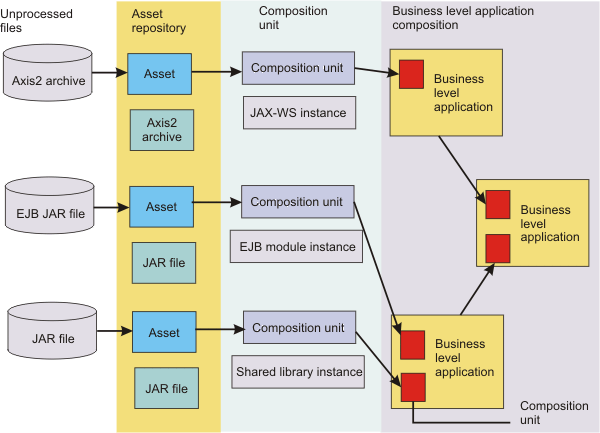Composition units
A composition unit represents a configured asset in a business-level application. A composition unit enables the asset contents to interact with other assets in the application. It also enables the product run time to load and run asset contents.
The product supports three types of composition units:
- Asset composition units
- Composition units created from assets by configuring each deployable unit of the asset to run on deployment targets.
- Shared library composition units
- Composition units created from JAR-based assets by ignoring all the deployable objects from the asset and treating the asset JAR file as a library of classes.
- Business-level application composition units
- Composition units created from business-level applications added to existing business-level applications.
A composition unit contains the following information:
- Configuration information that binds contents of an asset with a specific hosting run time and adds the configuration necessary for the run time to load and run the asset
- References to external
services, components, or other resources that the asset uses
- Customized configurations for service definitions, references and other relevant configuration data
- A list of deployment targets or runtime environments along with the runtime environment-specific configuration where the composition unit runs.
For example, a composition unit for an enterprise bean (EJB) JAR asset is an EJB module instance containing necessary EJB binding information, such as EJB JNDI names and ejb-ref resolutions, along with a list of application servers or clusters where the EJB JAR runs.
The product creates a composition unit from only one asset. However, multiple composition units can share a single asset. This is particularly useful in scenarios where different configurations use the same application binary files to provide different runtime behavior.
The following rules apply to a composition unit:
- A composition unit can exist only in a business-level application.
- Because a composition unit contains application-specific configuration and wiring information, multiple business-level applications cannot share an asset or shared library composition unit.
The following graphic shows the use of composition units in business-level applications. Assume that we have unprocessed files, such as archives, to use in business-level applications. Before we can add the files to business-level applications, first import the files as assets, which adds the files to the product repository. Next, we add the assets to business-level applications, which creates composition units for the assets. Business-level applications can contain asset composition units, shared library composition units, or business-level composition units.

Related concepts
Related tasks